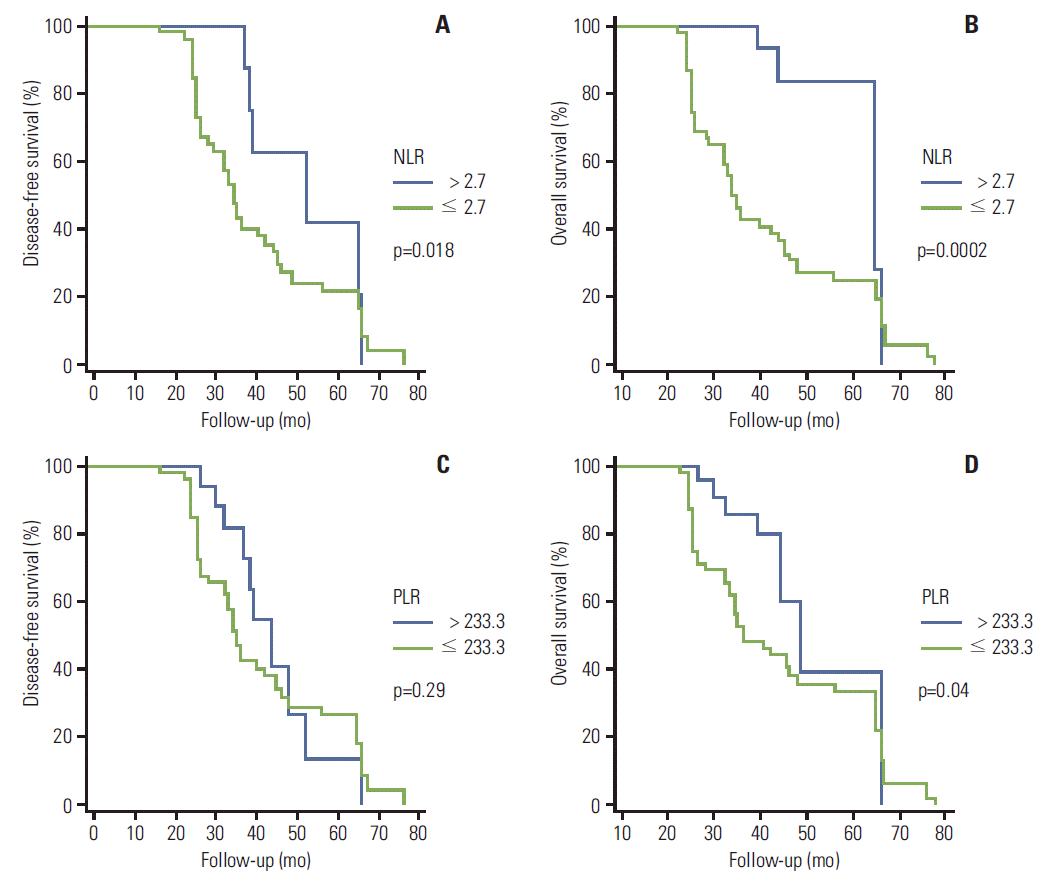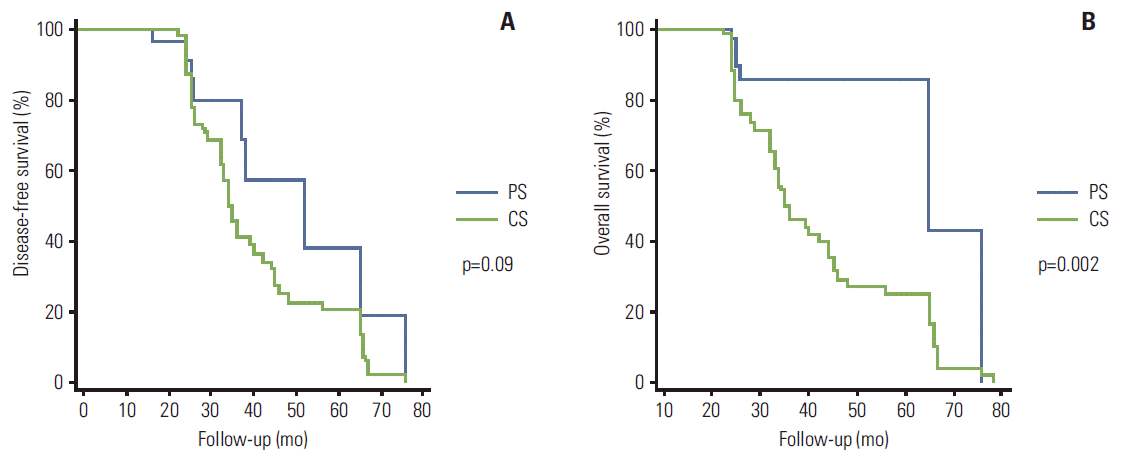1. Kurman RJ, Shih IM. The origin and pathogenesis of epithelial ovarian cancer: a proposed unifying theory. Am J Surg Pathol. 2010; 34:433–43.

2. Bidus MA, Maxwell GL, Ros GS. Fallopian tube cancer. In : Di
Saia PJ, Creasman WT, editors. Clinical gynecologic oncology. 8th ed. Philadelphia: Elsevier/Saunders;2012. p. 357–68.
3. Koo YJ, Kwon YS, Lim KT, Lee KH, Shim JU, Mok JE. Para-aortic lymphadenectomy for primary fallopian tube cancer. Int J Gynaecol Obstet. 2011; 112:18–20.

4. Klein M, Rosen AC, Lahousen M, Graf AH, Rainer A. Lymphadenectomy in primary carcinoma of the Fallopian tube. Cancer Lett. 1999; 147:63–6.

5. Gadducci A, Landoni F, Sartori E, Maggino T, Zola P, Gabriele A, et al. Analysis of treatment failures and survival of patients with fallopian tube carcinoma: a cooperation task force (CTF) study. Gynecol Oncol. 2001; 81:150–9.

6. Kalampokas E, Kalampokas T, Tourountous I. Primary fallopian tube carcinoma. Eur J Obstet Gynecol Reprod Biol. 2013; 169:155–61.

7. Tavares-Murta BM, Mendonca MA, Duarte NL, da Silva JA, Mutao TS, Garcia CB, et al. Systemic leukocyte alterations are associated with invasive uterine cervical cancer. Int J Gynecol Cancer. 2010; 20:1154–9.

8. Proctor MJ, Morrison DS, Talwar D, Balmer SM, Fletcher CD, O'Reilly DS, et al. A comparison of inflammation-based prognostic scores in patients with cancer. A Glasgow Inflammation Outcome Study. Eur J Cancer. 2011; 47:2633–41.

9. Lee YY, Choi CH, Kim HJ, Kim TJ, Lee JW, Lee JH, et al. Pretreatment neutrophil:lymphocyte ratio as a prognostic factor in cervical carcinoma. Anticancer Res. 2012; 32:1555–61.
10. Wang D, Yang JX, Cao DY, Wan XR, Feng FZ, Huang HF, et al. Preoperative neutrophil-lymphocyte and platelet-lymphocyte ratios as independent predictors of cervical stromal involvement in surgically treated endometrioid adenocarcinoma. Onco Targets Ther. 2013; 6:211–6.
11. Cho H, Hur HW, Kim SW, Kim SH, Kim JH, Kim YT, et al. Pre-treatment neutrophil to lymphocyte ratio is elevated in epithelial ovarian cancer and predicts survival after treatment. Cancer Immunol Immunother. 2009; 58:15–23.

12. Thavaramara T, Phaloprakarn C, Tangjitgamol S, Manusirivithaya S. Role of neutrophil to lymphocyte ratio as a prognostic indicator for epithelial ovarian cancer. J Med Assoc Thai. 2011; 94:871–7.
13. Asher V, Lee J, Innamaa A, Bali A. Preoperative platelet lymphocyte ratio as an independent prognostic marker in ovarian cancer. Clin Transl Oncol. 2011; 13:499–503.

14. Raungkaewmanee S, Tangjitgamol S, Manusirivithaya S, Srijaipracharoen S, Thavaramara T. Platelet to lymphocyte ratio as a prognostic factor for epithelial ovarian cancer. J Gynecol Oncol. 2012; 23:265–73.

15. Allensworth SK, Langstraat CL, Martin JR, Lemens MA, McGree ME, Weaver AL, et al. Evaluating the prognostic significance of preoperative thrombocytosis in epithelial ovarian cancer. Gynecol Oncol. 2013; 130:499–504.

16. Luomaranta A, Leminen A, Loukovaara M. Prediction of lymph node and distant metastasis in patients with endometrial carcinoma: a new model based on demographics, biochemical factors, and tumor histology. Gynecol Oncol. 2013; 129:28–32.

17. Hu CY, Taymor ML, Hertig AT. Primary carcinoma of the fallopian tube. Am J Obstet Gynecol. 1950; 59:58–67.

18. Sedlis A. Carcinoma of the fallopian tube. Surg Clin North Am. 1978; 58:121–9.

19. Schneider C, Wight E, Perucchini D, Haller U, Fink D. Primary carcinoma of the fallopian tube. A report of 19 cases with literature review. Eur J Gynaecol Oncol. 2000; 21:578–82.
20. Shamshirsaz AA, Buekers T, Degeest K, Bender D, Zamba G, Goodheart MJ. A single-institution evaluation of factors important in fallopian tube carcinoma recurrence and survival. Int J Gynecol Cancer. 2011; 21:1232–40.

21. Pectasides D, Pectasides E, Papaxoinis G, Andreadis C, Papatsibas G, Fountzilas G, et al. Primary fallopian tube carcinoma: results of a retrospective analysis of 64 patients. Gynecol Oncol. 2009; 115:97–101.

22. Deffieux X, Morice P, Thoury A, Camatte S, Duvillard P, Castaigne D. Anatomy of pelvic and para-aortic nodal spread in patients with primary fallopian tube carcinoma. J Am Coll Surg. 2005; 200:45–8.

23. Alvarado-Cabrero I, Stolnicu S, Kiyokawa T, Yamada K, Nikaido T, Santiago-Payan H. Carcinoma of the fallopian tube: Results of a multi-institutional retrospective analysis of 127 patients with evaluation of staging and prognostic factors. Ann Diagn Pathol. 2013; 17:159–64.

24. Balkwill F, Mantovani A. Inflammation and cancer: back to Virchow? Lancet. 2001; 357:539–45.

25. Konishi Y, Sato H, Fujimoto T, Tanaka H, Takahashi O, Tanaka T. Primary fallopian tube carcinoma: a clinicopathologic study of 10 cases. Eur J Obstet Gynecol Reprod Biol. 2008; 139:260–1.






 PDF
PDF Citation
Citation Print
Print



 XML Download
XML Download